By Jeffrey A. Rendall, Photos by Kevin Gaydosh
PINEHURST, NC – “They originally wanted to call it The Farm,” said Chuck Cordell, Director of Marketing at Forest Creek Golf Club, speaking of the minds behind one of the country’s premier private clubs. Located on rolling terrain in the golf mecca that is Pinehurst, North Carolina, Forest Creek’s two Tom Fazio-designed golf layouts have earned universal accolades from professional course raters and golf enthusiasts alike.
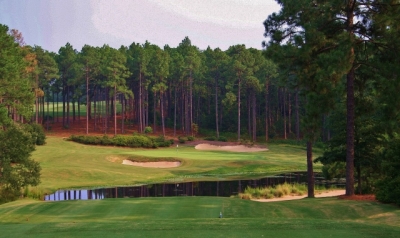 |
| The par three 17th hole displays the Augusta-like look of the South Course. |
Forest Creek was established in the early nineties by Terry Brown and his brother Louis Meyer Brown, on land they inherited from their grandfather, Charles Louis Meyer.
Cordell expands on some of the property’s history: “In the early 40’s, Louis Meyer assembled the land in the Pinehurst area, which eventually came to be about 3000 acres. He was into horses and hunting, while his wife enjoyed golf. When they’d come to Pinehurst for a retreat, she would play golf at the resort and Louis would go fox hunting.”
“They bought an old 1800’s farmhouse, which was on the property, and affectionately called it ‘The Farm’ even though it wasn’t really a working farm,” Cordell explained.
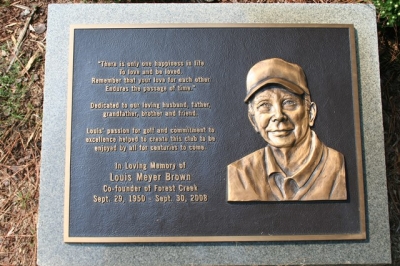 |
| Forest Creek Co-founder Louis Meyer Brown left us some lasting words of wisdom. |
Fast forward to near the end of the century, when Terry and his brother became the new owners of the acreage (upon the death of their grandmother) and decided that the best use for the property would be to turn it into a world-class golf club. As accomplished players themselves (their father had been an alternate to a Walker Cup team), the Browns knew quality when they saw it, and hired Tom Fazio to design the golf.
For his part, Fazio’s family had also enjoyed a long association with Pinehurst, and he appreciated the historic nature of the opportunity to work at Forest Creek. “For me, the most intriguing part of Forest Creek was creating a style of golf in what Pinehurst is perceived to be. When you think of Pinehurst, you think of Pinehurst #2, you think of Donald Ross, the history of it. The Tufts story, the resort, the North-South tournament. That’s what Pinehurst is – it’s all those pieces.”
Fazio continued, “So, Forest Creek was about making sure that you create golf courses that had the feel of Pinehurst – and with all that it is – and then, designing individual golf holes on their own. It wasn’t meant to be like Pinehurst #2 – because my design philosophy has never been to copy anything, including work I’ve done myself.”
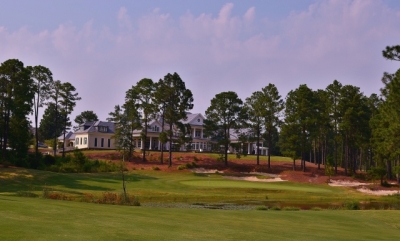 |
| The second shot to the par four 9th hole must carry a pond -- and is within the full view of the Forest Creek clubhouse. |
It’s true, Tom Fazio is no copycat. But the intention all along at Forest Creek was to have two golf courses. The South Course was first one built due its proximity to the property’s entrance (we’ll focus on the North Course in a separate story). Logistically speaking, it made sense to start there, and Fazio crafted a parkland-style layout with all the elements of Pinehurst that you would expect from the Home of Golf.
The North Course came several years after, incorporating more of a Pine Valley-style look featuring large waste areas with native sand. Despite occupying very similar plots of acreage, the two courses are beautifully distinct.
Fazio says it’s a myth that you would need different designers to get two distinctive golf courses. “From the design side, it’s kind of a fun thing to do two courses at the same club. You hear people say you’ve got to hire another architect to create a different style – and my answer to those people is, why do you need another architect? If you have the same people and the right management teams and the right ingredients, why not keep going with what you have?”
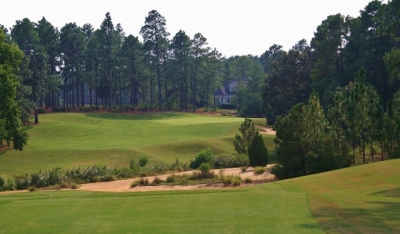 |
| The 224-yard, par three 10th hole requires a well-executed tee shot to begin the back nine. |
“The ultimate goal always is, when a member comes to the pro shop and they want to go and play, and they’re told that they can go and play this course or that course, it doesn’t make any difference – because people enjoy both of them, and that’s the mark of success,” Fazio said proudly.
As mentioned above, the South Course came first simply because of its location. But the founders made sure at the outset that both courses were to receive the best land for golf.
Cordell explained: “Tom Fazio was given carte blanche as to where he wanted to put the golf courses – 1265 acres total. There wasn’t any pre-determined idea as to where real estate was going to go and we didn’t say ‘hey, you can’t build over here, we want this for housing or we want this for village homes’ or otherwise restrict him.”
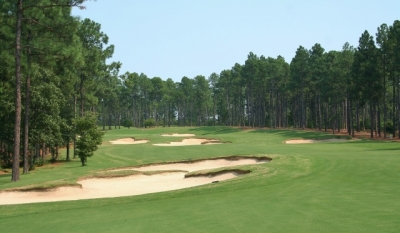 |
| Turning the corner on the slight dogleg left, par five 3rd hole. The second shot is uphill, so pick an appropriate spot for your lay-up. |
First dibs on land that was already ideally suited for golf allowed for layouts with exemplary shot values and visibility. As a result, there are a number of downhill approach shots where you can see the ball hit the green, which was important in the scheme of things.
Fazio too thought the land was near-perfect. “At Forest Creek, you have rolling sand hills with tree cover. Add in nice views and great vegetation, great understory, framing and definition for holes, and you also had some natural lake features. The environment and the setting was very, very conducive to golf.”
With more than generous landing areas off the tee, members will certainly enjoy the chance to hit shots and keep moving. The South Course’s greens are also a little gentler than the North’s, though neither would rate as exceptionally sloped or unfair. The Crenshaw bentgrass greens roll fast and true – and the conditioning is outstanding from tee to green (note: the club over-seeds one course in the winter, usually the South Course).
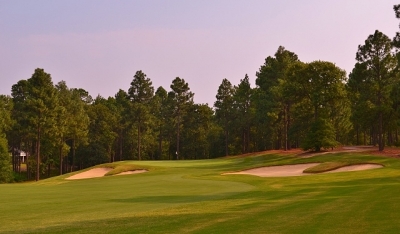 |
| Near the green of the long par five 12th hole, rated the most difficult on the back nine. |
Cordell says the South Course reminds him a little bit of another famous southern legend. “It’s got a very parkland feel to it, more of an Augusta-feel to it. There’re some big bowls and collection areas around the greens that give it special character. We brought in sand from the outside to fill the bunkers, so they’re distinguishable from the native sand. There are a few waste bunkers, but only a couple really come into play. They’re mostly for aesthetics.”
Both courses offer championship tests from the back tees, though members find the South layout to be slightly more scoring-friendly. The difference is a shot to shot and a half easier per nine, according to Cordell. The South Course also returns to the clubhouse after the outward nine – and perhaps for that reason, enjoys a little more member traffic.
The South’s championship tees (referred to as "The Cones" because of their pinecone tee markers) stretch to 7095-yards (slope of 139), and will tend to play somewhat shorter when considering the wide driving avenues and a few downhill tee and approach shots. The day we took it on was quite warm and the fairways were hard and fast, allowing for ample rolls – something to keep in mind when choosing a club on dogleg holes.
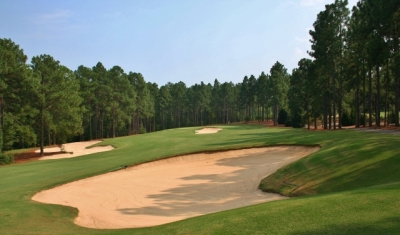 |
| Large bunkers frame the second shot landing area on the par five 7th hole. |
Four more sets of tees (appropriately named Long, Intermediate, Medium and Short) add playability for all levels. The “short” tees measure a little over 5000 yards, and take nearly all carries out of consideration.
Water only comes into play a few times on the South, most notably the second shot to the par four ninth, the tee shot on the par three seventeenth and on the approach to the par four eighteenth – though you’d have to pull it pretty badly to the left to find the water on the closing link.
The South’s bunkers are prevalent but not especially deep, and the sand is very well maintained – don’t blame the bunkers for misplays. They do have a rather prominent lip, which can be problematic if you’re trying to advance the ball from fairway bunkers.
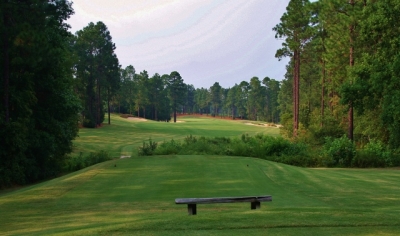 |
| Both Forest Creek layouts are easily walkable. Here, the par four 16th hole on the South Course. |
Favorite holes included the picturesque par three second hole, which requires a full carry over wetlands to reach a green protected by a large bunker to the front-right. Most notable about the hole is a plaque dedicated to the memory of co-founder Louis Meyer Brown – a fitting tribute to a man with a vision.
The par four ninth is memorable for its strategic as well as aesthetic qualities. The tee shot should favor the right side of the fairway to cut off distance on the second shot, which must fly a pond to reach the putting surface. Forest Creek’s clubhouse overlooks the ninth green – quite a view for players and anyone watching from the veranda.
The back nine begins with a demanding 224-yard par three, calling for a carry over a waste area that will not come into play for anything but a mishit. There’s a bunker protecting the front-right, and a large bailout area to the left of the green. For those choosing the bailout option, you’ll face one of those Augusta-like up-and-down situations that Cordell mentioned above.
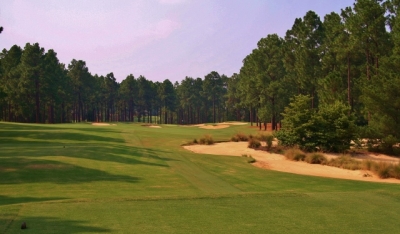 |
| The South Course also has waste areas, but they do not come into play like on the North Course. Here, the par four 8th hole. |
Similarly, the beautiful par three seventeenth encapsulates the look of Forest Creek’s South Course. If Fazio was aiming for the “Pinehurst feel,” this hole has it. Measuring 195-yards from the back tees, you’re playing slightly downhill over a pond to a well-protected, narrow green. The hole certainly resembles the famous twelfth hole at Augusta – not an unpleasant reference in the slightest.
The challenging 458-yard, par four eighteenth completes the round. The fairway landing area is well guarded by bunkers left, right and even short-left. If you manage to find one of them, a sizeable challenge awaits to reach the green, which is protected by bunkers to the sides and water long. You’ll certainly earn your par on the final hole.
Summing up, the South Course is a beautifully sculptured, natural layout with all the features and feel that you would like from Pinehurst. A classic, and a fitting member of the Pinehurst community.
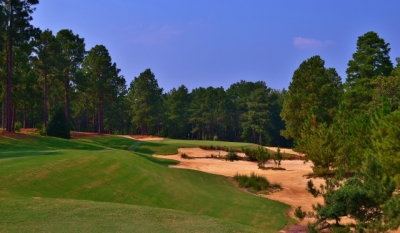 |
| A large sloped green awaits your tee ball on the par three 6th hole. |
Forrest Creek – More Than Just Golf
With the quality of the Fazio golf courses, it would be easy to think of Forest Creek merely as a great place to tee it up. But while golf is clearly the star of the show, it’s not the only aspect that allows Forest Creek to compete with America’s best high-end clubs.
Of course the facilities are outstanding, from the clubhouse, to the locker room, to the pool, to the fitness center. But at first glance, the club’s architectural scheme seems a little disjointed.
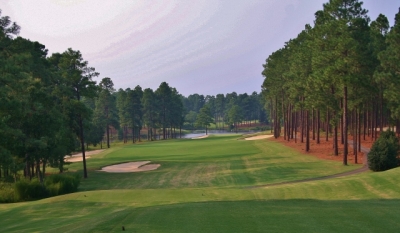 |
| The long par four 18th hole demands length and accuracy to earn a par. |
It’s not. It actually makes perfect sense.
Again, Cordell expounds: “The reason for mix and match in architectural style in the clubhouse is we tried to use the ‘family home place’ as a theme. As a result, our clubhouse was designed to look like a manor house. Then there’s a guest cottage out back, which was our original building and now holds our offices and administration. Next, our locker room looks like stables, so it fits the theme. Finally, there’s a log cabin on the property that serves as our pro shop.”
“So we used that as a theme to come up with our clubhouse complex.”
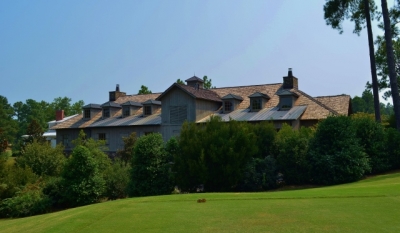 |
| The Forest Creek locker room embodies the rustic theme of the club. |
Other club amenities include tennis, walking trails, jogging trails and of course, fine and casual dining spaces.
The club was always intended for a worldly membership, which Cordell says they’ve achieved. “We’ve been very particular with the membership, with the majority of the members coming from the Midwest or the Northeast. We do have several international members, from all over -- South Africa, Portugal, England, and Scotland, as a representative sample.”
Cordell says if you did a pie chart on Forest Creek, over 50% of the membership is from out of state. Another 20% lives in North Carolina, but away from Moore County. About 25% live locally. So the club offers a great mix of demographics, especially if you like a first tee that will likely be available when you want it, and there isn’t a lot of pressure to force a pace on the golf course.
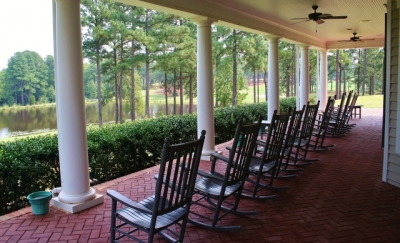 |
| The view from the clubhouse veranda is vintage Pinehurst. |
The service is everything you’d demand from a top club, and comes along with a heavy dose of southern hospitality. We felt right at home during our visit, which has not always been the case in that type of environment.
Simply put, Forest Creek offers an outstanding golf and club experience, one which should be considered if you’re interested in finding a high-end national club. Just take in the beautiful view from the veranda overlooking the ninth and eighteenth holes on the South Course, and you’ll know that you’ve truly found a home.
Click here for more background on Forest Creek Club, and for an in-depth look at the North Course.
Details:
200 Meyer Farm Drive
Pinehurst, NC 28374
Office: 910-295-9000
Fax: 910-693-1680
Click here for the Forest Creek Club website
Course Designer: Tom Fazio
Club Co-Founders: Terry Brown and Louis Meyer Brown
Director of Marketing: Chuck Cordell
Tees/Yardage/Slope/Rating (South Course)
Champion 7095 139/73.7
Long 6603 133/71.1
Intermediate 6292 130/70.0
Medium 5909 121/68.8 137/74.6 (L)
Short 5047 107/64.9 120/69.8 (L)
Membership Information:
Forest Creek Golf Club is a totally private, 100% equity club and one must own property to be a member. The membership may be attached to Forest Creek available forest and fairway lots or homes as well as 11 club house suites located above the newly completed clubhouse. The current initiation fee is $75,000 and dues are structured according to the member’s permanent home location. The membership will be closed at 750 members and there are presently approx. 525 members which include local, state, national and international members.
Consult the club’s website for more information.
| Related Links | Comments on this article? | |
|
Maryland National Golf Club Hollow Creek Golf Club Rocky Gap Resort PB Dye Golf Club in Ijamsville Whiskey Creek Golf Club |
E-mail Jeff Rendall, Editor: jrendall@golftheunitedstates.com |











